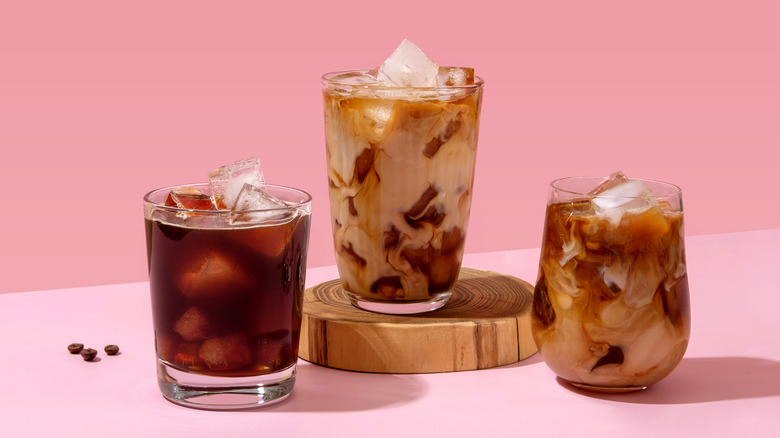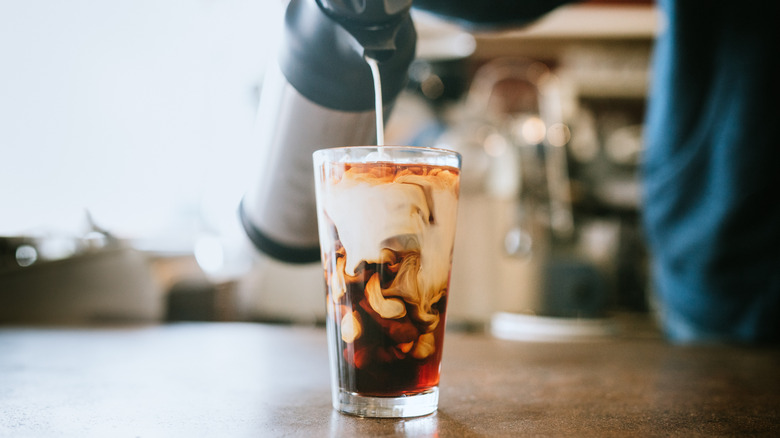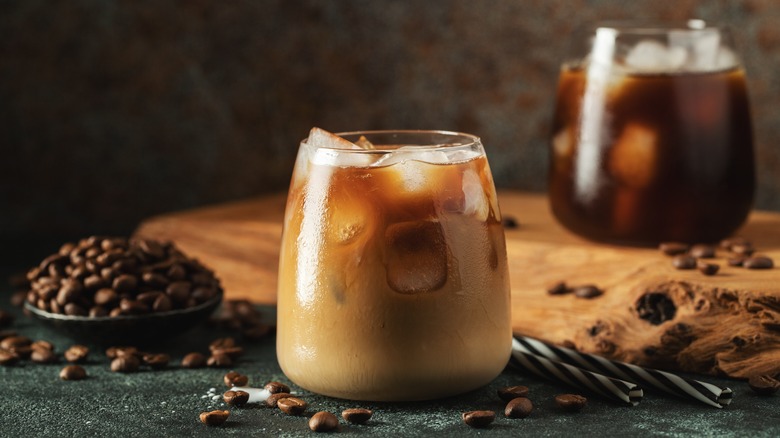Cold Brew Vs. Iced Coffee: Which Is Stronger?
The realm of café beverages is filled with a variety of drinks crafted from the nearly countless combinations of espresso, steamed milk, and brewed coffee. But while each drink is unique in its flavors and composition, at a glance, it's easy to confuse one beverage with another or think that two are one and the same. For example, while a coffee aficionado could tell you the exact differences between a latte and a cappuccino, those distinctions aren't as clear to the casual consumer. Such is the case for two titans of the caffeinated world: iced coffee and cold brew. Both beverages are served over ice and can be enjoyed with milk or flavored cream, but the similarities end there. In many regards, the two drinks are very distinctive, especially when it comes to how strong they are caffeine-wise.
Cold brew contains more caffeine than iced coffee. Amounts vary depending on exactly how each drink is made, but you can expect a 16-ounce cup of cold brew to have a little over 200 milligrams of caffeine, while the same amount of iced coffee only has about 165 milligrams. For reference, a shot of espresso contains 150 milligrams of caffeine. The disparity in caffeine content between the two drinks has to do with how they're made, which leads to other differences as well.
Cold brew is actually steeped
Iced coffee is made like a normal cup of joe, and can be brewed using various methods such as pour-over, drip, or espresso. It can also be made with any type of coffee beans, which means it is as customizable as typical hot coffee. No matter what technique is used, iced coffee starts when hot water extracts the flavors from coffee grounds. Then, it is either immediately poured over ice or refrigerated. It takes less than 10 minutes to make a good cup of iced coffee. Because the water used to make iced coffee is in contact with the ground coffee for a short period of time, it doesn't become infused with as much caffeine.
On the other hand, the process of making cold brew can take over one day, which is how the final product becomes so much more caffeinated. Contrary to its name, cold brew is steeped rather than brewed, much like a cup of tea. Rather than using hot water like iced coffee, cold brew is made by placing roughly ground coffee beans in cold water for anywhere from 12 to 24 hours. This prolonged period of extraction means that more caffeine is absorbed into the cold brew from the coffee grounds.
Other differences between the drinks
Cold brew and ice coffee's contrasting creation methods also result in flavor differences between the two. Due to its long steeping process, cold brew tends to have a robust, full-bodied flavor not achieved by iced coffee. When ice is added to regular drip or pour-over coffee, it quickly turns the beverage watery. This can dampen the flavor, make it more bitter without cutting out coffee's acidity, and impact the texture, too. Alternatively, cold brew usually has a smooth, sweet taste. It is often more common to see people drinking cold brew without any added cream or sugar, as opposed to iced coffee, which is usually given some adjustments.
That's not to say that iced coffee doesn't have its charms — it's literally cold coffee, so if you prefer the bright, tangy notes of a traditionally brewed java, then iced coffee is a perfectly refreshing way to get your caffeine fix. Cold brew's easy flavor makes it a bit more of a crowd-pleaser, but don't underestimate its caffeine content. If you're trying to unwind, iced coffee might be the better option between the two, as cold brew may leave some people bouncing off the walls.


